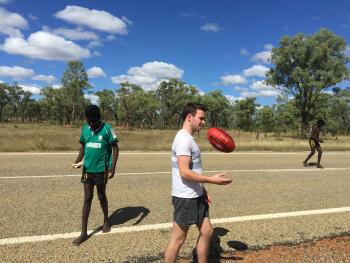Without assistance flying is out of the question. It can cost more to fly out of a region like Arnhem land than from Australia to London. So even when a profoundly rewarding experience is on offer that can set up high school, if you want it, under current Federal government policy settings, you have to invariably pay for the exorbitant airfares yourself or drive. Hopefully in the future things will change. Hopefully education officials will realise that they are currently investing in failure by only supporting travel to and from high school in remote and very remote communities.
Let’s make no mistake. Education must begin and end at home. And let’s have no doubt driving such distances can be onerous for all concerned. It is a tribute to the children, their parents and grandparents that they would take such journeys. But right now every kilometre adds value in a context of very poor school attendance, over-crowded, under-funded schools and housing - where basic standards of English literacy and numeracy may not be obtained by even the end of high school. A relatively short immersion in school and family in the south can reap life-long rewards, two way relationships and bi-cultural understanding. Such exchanges could have a profound effect on the outlook of all Australian children in the future. Above educational exchanges are about the best of both worlds interacting and ensuring mutual prosperity, growth and development.
For more download the pdf file: www.workingpapers.com.au/files/papers/driving_6700_kilometres_to_school.pdf
For comment: Peter Botsman 0244651665 or 0414218469
Downloadable files:
Driving 6700 Kilometres to School (26 page pdf)
Let’s make no mistake. Education must begin and end at home. And let’s have no doubt driving such distances can be onerous for all concerned. It is a tribute to the children and their parents and grandparents that they would take such journeys. But right now every kilometre adds value in a context of very poor school attendance, over-crowded, under-funded schools and housing and where basic standards of English literacy and numeracy may not be obtained by even the end of high school. A relatively short immersion in school and family in the south can reap life-long rewards, two way relationships and bi-cultural understanding. This is only the beginning of what can be a rich and rewarding series of educational exchanges that could have a profound effect on the outlook of all Australian children in the future. Above all this is about the best of both worlds interacting and ensuring mutual prosperity, growth and development.is it necessary in 2016 for two young Yol\u brothers and their cousin to drive 6703 kilometres back and forth from Arnhem land to the South Coast of NSW in pursuit of good primary schooling and engagement through a football and netball competition? The short answer is Abstudy does not cover school travel allowances for remote and very remote Aboriginal children at below age 14. Without assistance flying is out of the question. It can cost more to fly out of a region like Arnhem land than from Australia to London. So even when a profoundly rewarding experience is on offer that can set up high school, if you want it, under current Federal government policy settings, you have to invariably pay for the exorbitant airfares yourself or drive. Hopefully in the future things will change. Hopefully education officials will realise that they are currently investing in failure by only supporting travel to and from high school in remote and very remote communities.
Let’s make no mistake. Education must begin and end at home. And let’s have no doubt driving such distances can be onerous for all concerned. It is a tribute to the children and their parents and grandparents that they would take such journeys. But right now every kilometre adds value in a context of very poor school attendance, over-crowded, under-funded schools and housing and where basic standards of English literacy and numeracy may not be obtained by even the end of high school. A relatively short immersion in school and family in the south can reap life-long rewards, two way relationships and bi-cultural understanding. This is only the beginning of what can be a rich and rewarding series of educational exchanges that could have a profound effect on the outlook of all Australian children in the future. Above all this is about the best of both worlds interacting and ensuring mutual prosperity, growth and development.Without assistance flying is out of the question. It can cost more to fly out of a region like Arnhem land than from Australia to London. So even when a profoundly rewarding experience is on offer that can set up high school, if you want it, under current Federal government policy settings, you have to invariably pay for the exorbitant airfares yourself or drive. Hopefully in the future things will change. Hopefully education officials will realise that they are currently investing in failure by only supporting travel to and from high school in remote and very remote communities.



